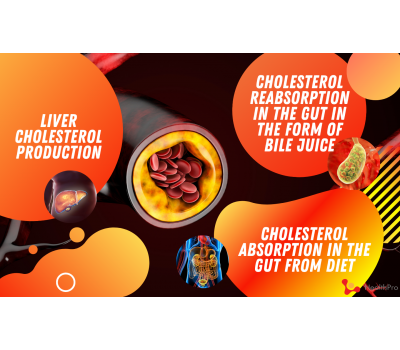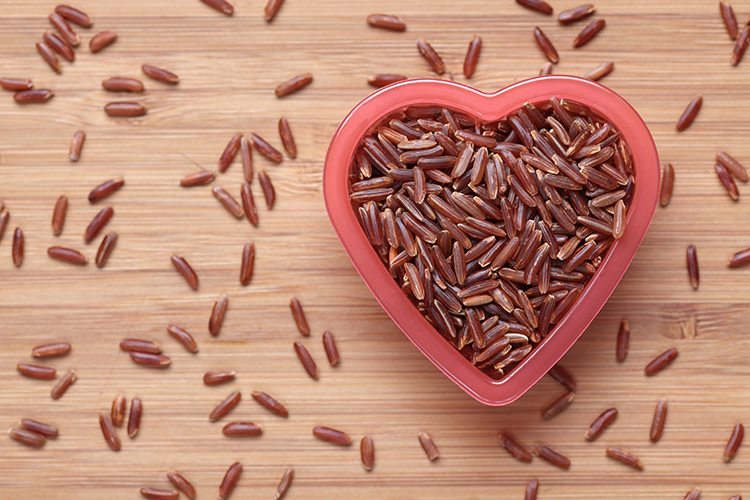Fight High Cholesterol Levels at the Root Causes


Cardiovascular disease is the second leading cause of death: a heart attack occurs every 5 seconds, a stroke every 6 seconds, 17 million people die each year from heart disease. According to the World Health Organization, half of deaths and disability cases resulting from a heart attack or stroke could be prevented by acting on cholesterol levels.
What is Cholesterol?
Cholesterol is a specific form of lipid or fat, partly made by the liver (endogenous), and partly provided by the diet (exogenous). It is essential to the body as it is a major component of cell membranes to ensure their fluidity and permeability. The metabolism of cholesterol is, for its part, the precursor of many molecules such as steroid hormones, bile acids, vitamin D and other substances.1
Cholesterol exists only in one form, but it is transported in the blood through two distinct types of protein: low-density lipoprotein (LDL) and high-density lipoprotein (HDL). LDL carries cholesterol from the liver to all cells. If the synthesis, absorption, transport and catabolism of cholesterol are not regulated, LDL-cholesterols accumulate and can contribute to the formation of plaques that gradually clog the arteries.
The coronary arteries, more likely to be the first affected, are fine arteries that nourish the heart muscle. If they get clogged, the heart cells will not be able to receive oxygen and blood, which will lead to heart attack (myocardial infarction).
Blockage can also happen in the arteries of the neck, known as the carotid arteries, which deliver blood to the brain, leading to cerebrovascular accidents, commonly called “cerebral attacks”.
REGULATE LDL CHOLESTEROL LEVELS NATURALLY WITH FUNCTIONAL NUTRIENTS
Red Yeast Rice to block the synthesis of cholesterol
 Red Yeast Rice has been used in China and other Asian countries for centuries as a traditional remedy. It is a substance extracted from rice after it has been fermented with red yeast called Monascus purpureus.
Red Yeast Rice has been used in China and other Asian countries for centuries as a traditional remedy. It is a substance extracted from rice after it has been fermented with red yeast called Monascus purpureus.
Red Yeast Rice contains several ingredients that control LDL (“bad”) cholesterol levels and lipids in the blood. Studies have shown that taking 2.4 grams of yeast Red rice reduces LDL cholesterol by 22% and total cholesterol by 16% in 12 weeks.
Red Yeast Rice contains more than 10 monacolins which have a chemical structure identical to statins, substances with powerful cholesterol-reducing action. The main monacolin of the yeast Red Rice is monacolin K. This is the natural equivalent of lovastatin, a classic synthetic drug prescribed in cases of high cholesterol levels. According to a 2008 study, results obtained with a supplement providing 10 mg natural monacolin K, are comparable to those obtained with 20 mg to 40 mg Lovastatin.2
It was also noted that the effectiveness of Red Yeast Rice on LDL cholesterol reduction is enhanced by its content of sterols, isoflavones and monounsaturated fatty acids or “healthy fats”. According to tests conducted in China, the yeast of Red Rice also seems to have positive effects on other factors of cardiovascular disease.
Caution: To be effective on cholesterol, the monacolin K content in yeast Red Rice should be about 10 mg.
Phytosterols, to repress the concentration of cholesterol
 Phytosterols are plant lipids that have a chemical structure very similar to that of cholesterol and partially hinder its attachment by occupying its absorption sites in the intestine. It has been demonstrated since the 1950s that long-term intake of phytosterols reduce the concentration of “bad” cholesterol (LDL) by 10 to 15% without affecting the level of “good” cholesterol. (HDL).3
Phytosterols are plant lipids that have a chemical structure very similar to that of cholesterol and partially hinder its attachment by occupying its absorption sites in the intestine. It has been demonstrated since the 1950s that long-term intake of phytosterols reduce the concentration of “bad” cholesterol (LDL) by 10 to 15% without affecting the level of “good” cholesterol. (HDL).3
 The digestion and absorption of cholesterol takes place in several stages. After breaking down the fat molecules, fatty acids and cholesterol will group together and form carriers known as micelles. Then, the content of the micelles will be absorbed into the bloodstream. Phytosterols disrupt this mechanism by competing with cholesterol in its solubility in micelles. Phytosterols displace some of the cholesterol within these “carriers”.
The digestion and absorption of cholesterol takes place in several stages. After breaking down the fat molecules, fatty acids and cholesterol will group together and form carriers known as micelles. Then, the content of the micelles will be absorbed into the bloodstream. Phytosterols disrupt this mechanism by competing with cholesterol in its solubility in micelles. Phytosterols displace some of the cholesterol within these “carriers”.
As the results, the free cholesterol is left in the intestine and eliminated in the stool. Phytosterols ensures a better elimination of LDL.
In addition, phytosterols act directly on the metabolism of cholesterol by reducing the activity of an enzyme, known as ACAT2, that involves in the key step for cholesterol transport from the intestine towards other tissues.
Recent research concludes that phytosterols are effective in preventing cardiovascular disease4 and also stimulating immune responses.
The simultaneous intake of phytosterols and statins (yeast of Red Rice) can further reduce cholesterol5: in fact, the two treatments have a complementary effect, statins reduce the production of cholesterol by the body, while phytosterols limit its absorption in the intestine.
 Guggul captures and “traps” the Cholesterol
Guggul captures and “traps” the Cholesterol
In India, the medicinal properties of Guggul, the resin of the Mukul Commiphora tree, have been recognized for millennia. Thus, according to Ayurvedic doctors, it eliminates “the accumulation of a fatty substance on the walls of blood vessels.”
The most interesting compounds of Guggul are Z- and E-guggulsterones which are phytosterols, with particular actions on hypercholesterolemia and hypertriglyceridemia.6
They allow:
- Activation of LDL-binding membrane receptors in the liver, leading to the increased uptake of LDL cholesterol in the blood.
- Increased production of bile acids in the liver that requires cholesterol, which in turn reduces cholesterol levels.7
The action of guggulsterones appears to be potentiated by the other components of guggulipid: a 10 to 30% decrease in blood lipid levels is observed depending on the conditions of the experiments and the subjects tested.
Guggulipid may also be beneficial:
- To treat acne (nodulocystic),
- To relieve some rheumatic inflammatory joint and tendon.
CONCLUSION
The health benefits of these three active ingredients are well established and their combination allows acting on endogenous and exogenous cholesterol, to regulate triglycerides and to rebalance the level of lipids in the blood.
Nevertheless, to be optimal, this combination must:
- Contain monacolin K from the yeast of red rice,
- Offer a dispersible form of phytosterols because phytosterols in nature are insoluble in both water and oil, therefore hardly ingestible.
Activa Well-Being Cholesterol helps to fight high cholesterol levels effectively by offering:
- Red yeast rice with its monocolin K.
- LIPOPHYTOL® in Activa Well-Being Cholesterol a dispersible form of plant sterols (from soy or pine tree origin) which has been microencapsulated to facilitate their incorporation in the supplement and allows good assimilation by the body.8
- Guggul.
References
- A lire: Patrick Lustenberger et jean André, Le métabolisme du cholestérol et des stéroïdes.
- Ong HT, Cheah JS. Chin Med J (Engl). Statin alternatives or just placebo: an objective review of omega-3, red yeast rice and garlic in cardiovascular therapeutics. 2008 Aug 20;121(16):1588-94.
- Lichtenstein AH, Appel LJ, et al. Summary of American Heart Association Diet and Lifestyle Recommendations revision 2006. Arterioscler Thromb Vasc Biol. 2006 Oct;26(10):2186-91. Review.
- Demonty I, Ras RT, et al. Continuous dose-response relationship of the LDL-cholesterol-lowering effect of phytosterol intake. J Nutr. 2009 Feb;139(2):271-84.
- Jong A, Plat J, et al. Effects of long-term plant sterol or stanol ester consumption on lipid and lipoprotein metabolism in subjects on statin treatment. de Br J Nutr. 2008 Nov;100(5):937-41.
- Kelly M. Shields, Pharm.D, Michael P. Moranville, Guggul for Hypercholesterolemia, American Journal of Health-System Pharmacy. 2005;62(10):1012-1014.
- Bruneton Jean, Pharmacognosie, phytochimie, plantes médicinales, 4e ed, pages 898 à 900.
- Sirle Laos et. al. Long-term intake of soyabean phytosterols lowers serum TAG and NEFA concentrations, increases bile acid synthesis and protects against fatty liver development in dyslipidaemic hamsters. Br J Nutr. 2014 Sep 14;112(5):663-73. Epub 2014 Jun 16.
Learn More About Activa Well-Being Cholesterol, 30 Vegetarian capsules


Social Login